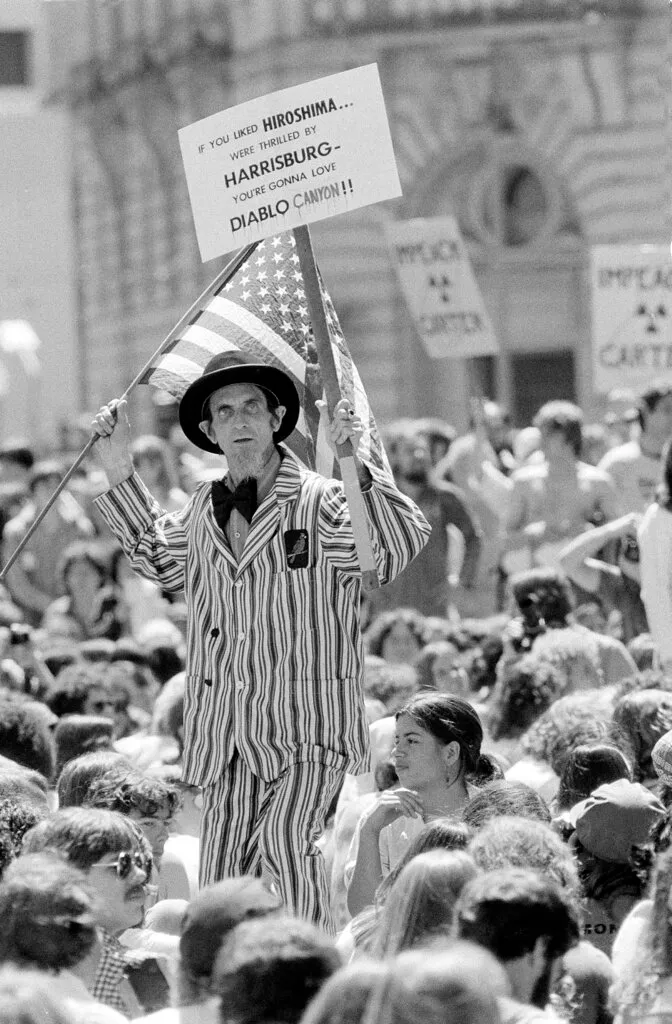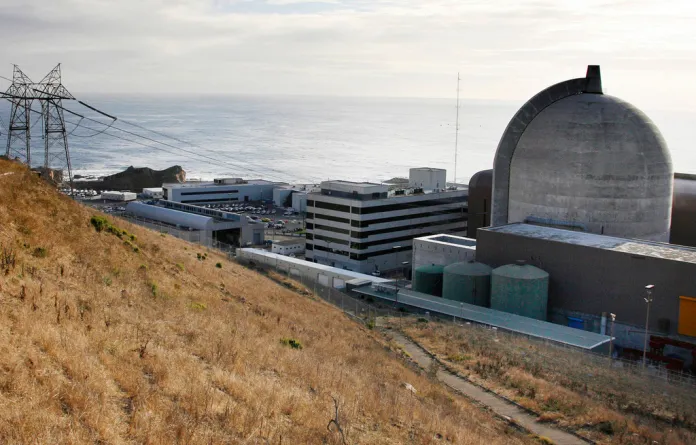


Nuclear energy has been stymied by Californian law for nearly five decades, hurting the state’s ability to hit its own climate goals and meet growing demand for electricity.
The construction of nuclear energy projects, such as power plants, has been blocked in the state of California since the mid-1970s. In 1976, the state placed a moratorium on the licensing and construction of nuclear reactors until the federal government established a permanent solution for radioactive waste disposal.
Recommended Stories
- Colorado boosts EV rebates as federal incentives end
- Democrats grill nuclear regulator nominee over safety and legality of Trump agenda
- NPS clears small homeless encampment in park near White House during shutdown
There were two operating nuclear power plants in the state at the time, with a third under construction. These facilities were not directly affected by the moratorium, as they already had received the necessary permits.
But costs associated with operating and addressing equipment failures grew and anti-nuclear sentiments persisted, causing the Rancho Seco and San Onofre nuclear facilities to shutter permanently in 1989 and 2012 respectively.
Since 2012, California has only had one operating nuclear power plant: Diablo Canyon, near San Luis Obispo.
The anti-nuclear campaign
Opposition to nuclear energy in California can be traced back to the 1950s, when the Atomic Energy Act was passed in order to boost domestic nuclear power development.
In the late 1950s and early 1960s, California residents successfully campaigned against the construction of a nuclear plant in Bodega Bay, roughly 70 miles north of San Francisco, citing concerns about public health, radioactive waste containing the ocean, and the risk of earthquakes due to the proposed plant’s location.
These grassroots protests were quickly boosted by environmentalist groups like the Sierra Club, which supported citizen protests and legal action against proposed projects.

The anti-nuclear campaign peaked in the summer of 1976, when residents were asked to vote on the “Nuclear Power Plants Initiative Statute,” which would place a complete ban on new nuclear plants and impose additional restrictions on those already operating. The measure failed, but it laid the groundwork for the moratorium passed later that year through amending the Warren–Alquist Act, which created the California Energy Commission, which oversees approvals of new energy projects.
While it was not intended to prohibit nuclear energy in the state, nuclear advocates have labeled the moratorium as a “ban,” as it has continued to hamstring nuclear development after nearly 50 years.
Lost investment
Nuclear energy proponents have argued that the moratorium has placed California in somewhat of a “hypocritical” position, as officials have sought to phase out fossil fuels and accelerate the deployment of clean energy.
At the same time, though, the state has continued to import electricity generated by fossil fuels like coal and natural gas from its Northwestern and southwestern neighbors. In 2023, California imported roughly 4,724 GWh of coal-generated electricity, according to the California Energy Commission.
“It’s just incredible hypocrisy to outsource your pollution to places like Wyoming,” Gene Nelson, president of the Californians for Green Nuclear Power, told the Washington Examiner.
Research has also suggested that with the moratorium on nuclear in place, California won’t be able to hit its goal is reaching net-zero emissions by 2045 on its own — meaning the amount of emissions released into the atmosphere is balanced with the amount being removed.
Adam Stein, the head of the Nuclear Energy Innovation program at the Breakthrough Institute, told the Washington Examiner that California will be forced to import even more electricity generated by wind and solar in neighboring states, particularly as demand rises.
In snubbing nuclear power, analysts estimate, California is losing billions of dollars worth of investments as large technology companies look to expand their AI operations.
A study, co-authored by Stein, conducted by the Breakthrough Institute in 2022, found that the state will have up to $12 billion of unrealized capital investments between 2020 and 2040 if its laws limiting nuclear power remain in place.
“It’s a lost opportunity for the state,” Stein said. “There are some communities, particularly near Diablo Canyon, that would like to host additional nuclear power…There’s a lot of investment and a lot of additional follow-on investment from growing industries, such as hyperscalers, [who] need additional electricity availability in order to grow in the state.”
If California takes too long to open itself back up to nuclear power, some advocates warn potential investors will flee to other states that have greater energy flexibility.
“Without access to abundant — ideally non-polluting — electricity, they’re going to have to take their business elsewhere,” Nelson said.
“We look at states like Texas that are really trying to roll out the red carpet to get data centers to move to Texas, it’s very significant,” he continued. “And even other blue states like New York are saying, ‘Hey, we recognize that we need this nuclear power electricity,’ and they’re at least making the right sounds that they need more nuclear power in New York State.”
Efforts to amend the bill
The benefits of nuclear power in California haven’t been lost on clean energy advocates and Democrats, as there have been several attempts to either fully roll back or amend the law within the last 20 years.
As early as 2008, state lawmakers attempted to fully repeal the moratorium and instead ban the Energy Commission from certifying nuclear power plants in seismically active areas. It would also require state agencies to consider storing radioactive waste in steel leak-tight containers on sight — a method known as Dry Cask Storage that is already approved by the Nuclear Regulatory Commission — as an appropriate solution for permanent waste storage. The measure died before making its way out of committee.
Similar proposals to make small modular reactors exempt from the moratorium have also failed to be put to a vote.
Most recently, two Republican assembly members and one Democrat introduced a bill that would also lift restrictions on new SMR facilities. This bill also has yet to move out of committee.
While interest in growing, many supporters of the technology are not surprised that these efforts have failed.
“I don’t think [nuclear energy has] been good enough until now,” Ryan Pickering, an energy developer and nuclear power advocate, told the Washington Examiner. “And so I think this is a really ripe time for California to change its mind.”
What’s next
Leading Democrats in the state, including State Senators Henry Stern and Scott Wiener, have publicly expressed their openness to building new nuclear energy facilities in California. Even Democratic Gov. Gavin Newsom has signaled an interest in keeping the Diablo Canyon plant open to help reach the state’s climate goals.
However, the growing bipartisan support for the carbon-free source of energy likely won’t be enough to walk back the moratorium within the next year.

For folks like Pickering and Nelson, the focus should instead be on keeping Diablo Canyon open.
The nuclear plant was initially slated to close in this year before its life was extended to 2030 last year. Now, supporters are looking to extend that further to 2045.
“We are a little hesitant to try to repeal the moratorium next year, out of respect for the proceedings of saving Diablo,” Pickering said. “But there are ideas about other bills, like workforce development, moving our nuclear fuel around, feasibility studies that we’d like to propose as well to kind of normalize nuclear and make it a less binary issue.”
Nuclear advocates say that, if Diablo Canyon does receive the license extension from both state agencies and the NRC, they may have the momentum to repeal or amend the moratorium. They would face pushback, though.
Amanda Halter, a managing partner with Pillsbury law focused on environmental and natural resources issues, told the Washington Examiner that internal politics within the Democratic Party could delay any change, particularly as left-leaning groups like the Sierra Club continue to advocate against nuclear power.
“Those politics play into it hugely, because those are very important local constituencies. They’re very important constituencies in terms of the politics of simply getting out of committee in California,” Halter said. “Those groups are incredible at organizing, and they are influential with legislators.”
CAN TRUMP TEAM MEET AMBITIOUS NUCLEAR ENERGY DEADLINES?
As the nuclear renaissance continues to make its way across the U.S., Halter pointed out that many environmental and climate-focused groups are becoming more open to nuclear power.
“It wouldn’t surprise me if some of those groups that have historically been anti-nuclear change their tune,” she said.
